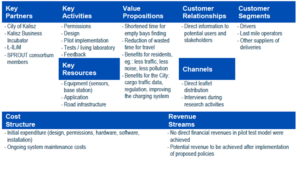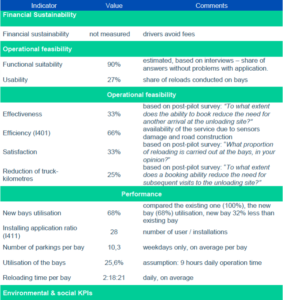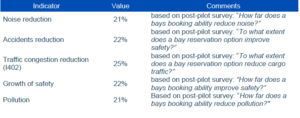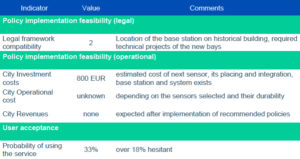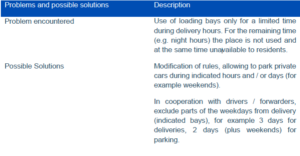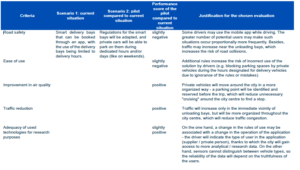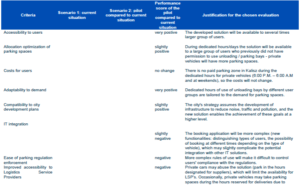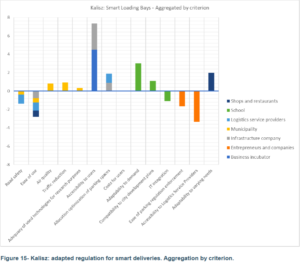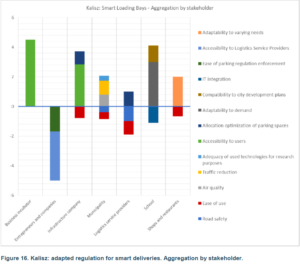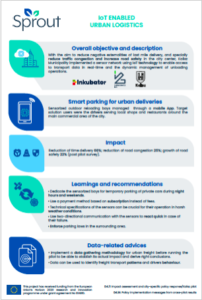Description
The distribution of goods strongly contributes to the increase of traffic in the city centre. Goods deliveries require unloading spaces that are convenient enough to unload the cargo fast and do not cause additional disturbances when the activity is on-going. The main objectives and obligations arising from the Development Strategy of the City of Kalisz for the period 2014-2024, which fit into the local low emission management plan, was taken into consideration.
Within the framework of the agreed objectives, particular measures and support need to be provided above all for infrastructure projects that aim at improving the state of roads and air protection, particularly in the areas where acceptable concentrations of pollution are exceeded.
The consequences of the transportation problems in the downtown of Kalisz and solutions proposed constituted the subject for further expertise and observation of adaptation of solutions commonly applied in Polish and Western European cities to the local conditions of Kalisz.
The main objectives and obligations arising from the Development Strategy of the City of Kalisz for the period 2014-2024, which fit into the PGN (low emission management plan) was taken into consideration.
Within the framework of the agreed objectives, particular measures and support need to be provided above all for infrastructure projects that aim at improving the state of road congestion and air pollution, particularly in the areas where acceptable concentrations of pollution are exceeded.
In terms of transport infrastructure, it is proposed to limit the negative influence of transport on the natural and living conditions, which is directly addressed by the loading bay sensoring project, which proposes a preliminary management system for freight transport operations and provide some rough statistics on the amount of freight traffic in the city centre.
The consequences of the transportation problems in the downtown of Kalisz and solutions proposed constituted the subject for further expertise and observation of adaptation of solutions commonly applied in Polish and Western European cities to the local conditions of Kalisz. In the case of Sprout pilot innovative solution based on IoT technology has been tested.
Before the project implementation, there were already loading bays in Kalisz. The rules and regulations of using them have not changed – a driver occupying a bay was obliged to pay a fee in a parking machine. As this obligation requires additional time and money, it is frequently avoided. Parking zone control is not so common to convince drivers to pay for parking, especially as in most cases the unloading operation takes only a few minutes. In addition, some drivers, mainly couriers confirmed lack of allocated budget for parking fees.
The start of the pilot was slightly postponed because of the technical problems with the base station connection to the Internet that was a necessary condition for exchanging of information. The preferred wire access offered by the City Hall was impossible to be correctly configured. It was then decided to connect wirelessly by Long Term Evolution (LTE) modem. The process of delivery and installation of the modem consumed additional time, which forced the prolongation of the tests to the end of February.
After implementation, the time was mainly dedicated to monitoring of the statistics recorded by the system. Additionally, some disturbances of diverse nature appeared due to low battery, humidity, or malfunction warnings causing inability of data recording. Any situations that may cause lack of direct communication with the sensor require immediate reactions, and should be the relevant subject to be necessarily solved in possible future implementations.
The operational feasibility of the technical solution, as described above gave many doubts, especially in the field of sensors durability. One of the sensors was damaged, probably while removing snow, as the moment when its work was interrupted coincided with significant snowfall. The second one has been leaked. The third one stopped working just before data collection (undefined reason). This means that during the four-month test, all 3 sensors failed throughout.
Further problems with the sensors aroused after their installation on the parking surface. The sensors did not provide information about deviations – only during the parking operations the cars changed sensors status and made them communicate via the base station to the server providing status information in real time. It was not possible to get the status of a sensor as such and be informed automatically if it was operating, without changing the status: occupied or not. For the purposes of further tests, it is advisable to use sensors placed under the road surface (lower possibility of damage) and with the possibility of incidental two-way communication to assess the state and status of the sensor on an ongoing basis. Unfortunately, this is associated with an increased demand for electricity and thus a shorter battery life.
It is not easy to state whether a four-month period is sufficient to evaluate the solution, especially given the limited actions in terms of freight operations caused by pandemic period, the limited scale of the implementation as well as the technical constraints resulting from the use of physical infrastructure. It should be assumed the users of the system should be given time to learn about its functionality and get used to it. The pilot installation operated for a relatively short period of time and under unique conditions and limited scope. People often need some time to get used to such solutions. Drivers basically adopted the new bays immediately but were not convinced by the common use of the application.
The key performance indicators were divided in set-up report into two areas: in scope of sustainability assessment of the pilots’ impacts and City specific policies for harnessing the impact of new mobility systems. Data were derived from the sensors system and from the post-pilot survey (see Table 4).
The assessment of the solution is positive and recommends to implement similar solutions in other locations. The reduction of travel time (distance) and manoeuvring time reaches nearly 30%, reduction of subsequent visit even 34%. The reduction of cargo traffic as a result of the booking possibility has been rated at 25% (I402), reduction of pollution and noise at 21%, similarly to safety improvement (22%). And as stated before 33% of all reloading operations are carried out, on reloading bays.
The formulation of policy responses follows a Stakeholder-Based Impact Scoring (SIS) approach. The following paragraphs outline the results and findings form applying this method to the Kalisz Pilot.
Practical information on the selection of stakeholders can be found in the section “Co-creating and utilizing scenarios” and in the SPROUT catalogue of urban mobility stakeholders
Stakeholders mainly consisted of local businesses including shops, convenience stores, pharmacies, drugstores that are deliveries customers and suppliers. Bars and restaurants were either entirely closed or limited exclusively to take-aways due to the pandemic. Moreover, delivery companies were asked to assess the impact of the solution.
- Kalisz Municipality;
- Infrastructure (Road and street lighting, Municipal Roads Administration);
- Business incubator;
- School;
- Entrepreneurs and companies (Photovoltaic company, Design office);
- Logistics Service Providers;
- Local shops and restaurants
Practical information on the SIS approach is provided under the toolbox section Analysis Phase and Policy Responses
The first step in the SIS approach is the identification of problems that cities have encountered during the implementations and potential policy responses to address these challenges.
The section below gives an overview of the identified problems and proposed policy solutions for the city of Kalisz.
Based on the assessment and the problem identification, the following addition to the pilot project was derived:
Smart bays will be introduced with adapted regulations: private cars will be able to park on them during dedicated hours and/or days (like on weekends).
For subsequent stages, the pilot project in combination with the proposed policy solutions will be referred to as alternative pilot.
Policy recommendations were derived building on the knowledge and the preferences of key stakeholder groups. The key question for the formulation of criteria is the following: what distinguishes a good project alternative from a bad one? Stakeholders therefore reflect on what their objectives are with the implementation of a project. These criteria can be both positive and negative, and examples include traffic safety, cost, or accessibility.
The following table indicates the criteria that were identified by the stakeholder groups:
Kalisz City Hall;
- Road safety
- Ease of use
- Improvement in air quality
- Traffic reduction
- Adequacy of used technologies for research purposes
Infrastructure (Road and street lighting, Municipal Roads Administration);
- Accessibility to users
- Allocation optimization of available parking spaces
- Ease of use
Business incubator;
- Costs
- Accessibility
School;
- Adaptability to demand
- Compatibility to city development plans
- IT integration
Entrepreneurs and companies (Photovoltaic company, Design office);
- Ease of parking regulation enforcement
- Improved accessibility to Logistics Service Providers
Logistics Service Providers;
- Ease of use
- Allocation optimization of parking spaces
- Road safety
Local shops and restaurants.
- Ease of use
- Adaptability to varying needs
In a later stage, stakeholders were asked to indicate the importance of the collected criteria for a successful project implementation. This weighting shows the relative importance that the stakeholders attach to each criterion.
In the next step, stakeholder criteria were brought together with the policy solutions identified in step 1. Aim was to understand, whether the alternative pilot (step 1) reflects stakeholder criteria to a higher or to a lower degree than the original pilot without additional interventions. SPROUT research partners assessed the effects of the alternative pilot with policy implementation compared to the pilot without policy changes for each of the stakeholder criteria. The alternative is given a performance score on a 7-point scale, ranging from ‘Very negative’ to ‘Very positive’.
As can be seen in the figure below, ‘accessibility to users’ is expected to be by far the most important positive impact, followed on distance by ‘adaptability to demand’, ‘adaptability to varying needs’ and ‘allocation optimisation of parking spaces. The considerable negative impacts include ‘ease of use’, which is considered relevant for multiple stakeholders, as well as the ‘accessibility for logistics service providers’.
The following figure shows the distribution of positive and negative impacts by stakeholder groups. For most stakeholders, impacts are generally considered positive, though for most stakeholder the pilot scores negatively in terms of ease of use. The impacts for logistics service providers and especially entrepreneurs and companies are expected to be mostly negative. For the latter stakeholder, this is due to the negative scores with regard to accessibility for LSPs and ease of parking regulation enforcement.
Building on the previous steps, SPROUT partners derived a list of policy responses, based on the SPROUT policy inventory. The following policy measures have been suggested:
- Policy Measure 1 (PM1): Adapted regulations for smart bays, with private cars able to park on them during dedicated hours and/or days (like at weekends)
- PM2: Environmental criteria in public delivery contracts (bike delivery, e-vehicles, etc.)
- PM3: Provision of inner-city micro-consolidation centres
- PM4: Weight and/or size restrictions for delivery vehicles
For the stakeholders, PM1, “Adapted regulations for the smart bays, with private cars able to park on them during dedicated hours and/or days (like on weekends)”, may require high maintenance costs. First, to have enough sparse parts, and second, to monitor, analyse and visualise results with automatic reports and dashboards. To reduce replacement parts costs, Kalisz suggests selecting the appropriate sensors based on the weather conditions. Regarding user acceptance, PM1 is not affordable. For the residents, the reason might be that the communication was unclear, so the results are not representative. For the freight drivers with shorter times than 5 minutes that avoid fees, this measure may force them to pay. The solution is to create subscriptions that help them to save time too.
PM2, “Environmental criteria in public delivery contracts (bike delivery, e-vehicles, etc.)” is the most controversial measure for the stakeholders while well received by users. The reasons are that it will require the operators to replace the fleet and reorganize the logistics operations. Both will entail high investments (fixed costs) and operational and maintenance costs and impact. The need to accommodate the logistic network and the lack of operators with the convenient fleet makes the measure politically infeasible. The city may assume the additional costs to avoid increasing the price to the consumers, promote on the public administration webs to attract contractors and make clear this example is a trend of the city and not just a one-off requirement. The benefits of this policy measure are unclear due to the difficulties in quantifying the impact on health.
PM3, “Provision of inner-city micro-consolidation centres”, arises technical problems related to the lack of knowledge and ICT resources that might be solved by outsourcing a pilot and learning from the experience. Education programmes and dissemination activities are considered essential for understanding the benefits and operation requirements. Indeed, the user acceptance test results confirm that these mitigation strategies may reduce the gap between the real effects of this policy measure and the personal and social aims and increase the knowledge and level of information. Moreover, education programmes and dissemination activities are the foundational requirements for covering last-mile deliveries efficiency problems awareness and perception.
PM4, “Weight and/or size restrictions for delivery vehicles”, as occurred with PM2, might be problematic just for the stakeholders. In this case, it will increase the operational costs and generate some political unfeasibility. Both issues can be mitigated if the measure is introduced gradually. Indeed, the experience from Western cities creating more social environments is well-recognized by the stakeholders.
To conclude, PM1 is regarded the best supporting policy for scaling the mobility solution to other locations within the city boundaries. PM4 introduced gradually may help to create more social environments while reducing stakeholders’ opposition. The city should increase the efforts for building the knowledge gap and the ICT and logistics infrastructure needs that support other policy measures such as PM3. In the short term, a pilot with support from an experienced company may help overcome these barriers. Finally, PM2 might not be an appropriate policy measure in the short run. The benefits are hard to quantify and the number of infeasibilities found may represent a difficult barrier. Once the city improves last-mile efficiency perception and awareness through education programmes and dissemination, PM2 can be revisited and assessed again.
Key learnings and recommendations
The following key messages were derived from the pilot:
- Dedicate the sensorized bays for temporary parking of private cars during night hours and weekends.
- Use a payment method based on subscription instead of fees.
- Technical specifications of the sensors can be crucial for their operation in harsh weather conditions.
- Use two-directional communication with the sensors to react quick in case of their failure.
- Enforce parking laws in the surrounding area.
- Implement a data gathering methodology for urban freight before running the
- pilot to be able to stablish its actual impact and derive right conclusions.
- Data can be used to identify freight transport patterns and drivers behaviour.
SPROUT materials and tools
Other relevant tools and methods
Further Information
Kalisz SUMP: plan zrównoważonego rozwoju publicznego transportu zbiorowego dla miasta kalisza

